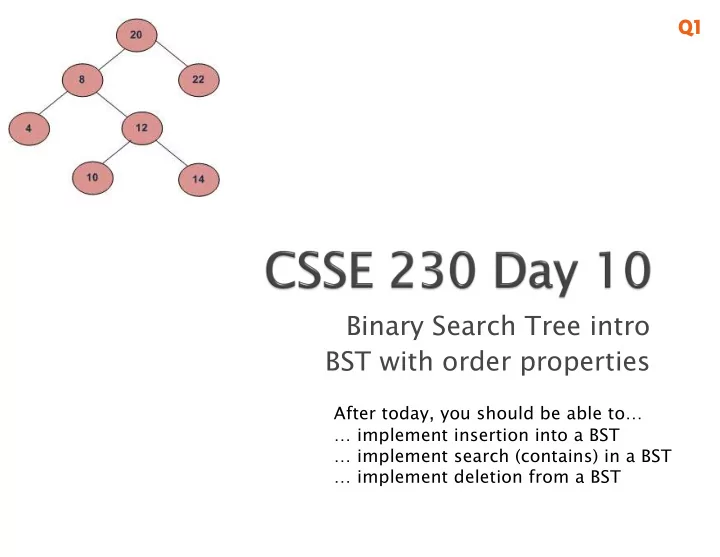

Q1 Q1 Binary Search Tree intro BST with order properties After today, you should be able to… … implement insertion into a BST … implement search (contains) in a BST … implement deletion from a BST
Q1 Q1 § Doublets § Due tonight § Team eval due the day after you submit § Behavior of different ChainManagers? § Efficiently populating the Links data structure? § Upcoming assignments: HW4, BST § Quiz review problems
Binary Trees that store elements so that an they appear in increasing order in an in-order traversal
A BST is a Binary Tree T with x these properties: 1. Elements are Comparable, and < x > x non-null 2. No duplicate elements (we T L T R implement TreeSet) BST BST 3. All elements in T’s left subtree are less than the root element 4. All elements in T’s right subtree are greater than the root element 5. Both subtrees are BSTs
Q2 Q2 § Search (contains) is now easier, and possibly more efficient § Why? § What can we say about running time of contains()?
Q3 Q3-4 § Rule of thumb: insert at a null-node location. § Only one such location will maintain search property! Class activity: Draw a "birthday BST”!
§ To insert a node, § Compare to know which child to recurse on § We recognize where to insert once we’ve found the NULL_NODE. Why won’t the following code work? class BinaryNode { //... void insert(T item) { if ( this == NULL_NODE) { this = new BinaryNode(item); Bad code } // ... } } § It’s the calling object (parent node or BST itself) who should really attach the new node!
Q5 Q5 When NULL_NODE is found, return a new node. Parent who called insert on the NULL_NODE then sets the returned value to be its appropriate child left = left.insert(80); NULL_NODE return new BinaryNode(80); For it to work, other nodes along the recursive descent should return .
Q6 Q6 § How to handle each case using the recommended recursive pattern? § No children § 1 child § 2 children https://en.wikipedia.org/wiki/Binary_search_tree#Deletion Hibbard deletion: http://dl.acm.org/citation.cfm?id=321108
Q7 Q7 § Each recurses down only one branch of the tree! § So what can we say about worst-case big-O runtimes?
public class BinarySearchTree<T extends Comparable<T>> { private BinaryNode root; public BinarySearchTree() { this.root = NULL_NODE; } // Does this tree contain x? public boolean contains(T x) // insert x. If already there, return false public boolean insert(T x) // delete x. If not there, return false public boolean delete(T x) // 3 cases
§ Challenge: § The recursive BinaryNode.insert() returns a BinaryNode. (Child to parent: “This is the root of my subtree”) § We want our BST.insert() operation to return a boolean (“The node was/wasn’t successfully added”.) § How do nodes communicate this boolean up the tree, when their return value is already used? § Could let the boolean be a BST field. But, poor encapsulation: sticks around even outside call to insert(). § Two alternative solutions: § Can the helper method return 2 things? § Create a simple composite class to hold both a boolean and a BinaryNode. § Can you pass a parameter to the helper method and mutate it? § Java uses call-by-value, and a boolean is a primitive so can’t be mutated. Even Booleans can’t be mutated as the class is declared final. § Create, and pass a simple BooleanContainer object so you can mutate the boolean inside.
§ Modifying (inserting/deleting) from a tree should cause any active iterators to fail the next time the active iterator is accessed (i.e., throw a ConcurrentModificationException ). § How do you detect this? § Modification count § How do you implement an iterator’s remove()? § Just call BST remove(). § But throw exceptions if next() hasn’t been called, or if remove() is called twice in a row. (Javadoc for TreeSet iterator has details.)
Recommend
More recommend